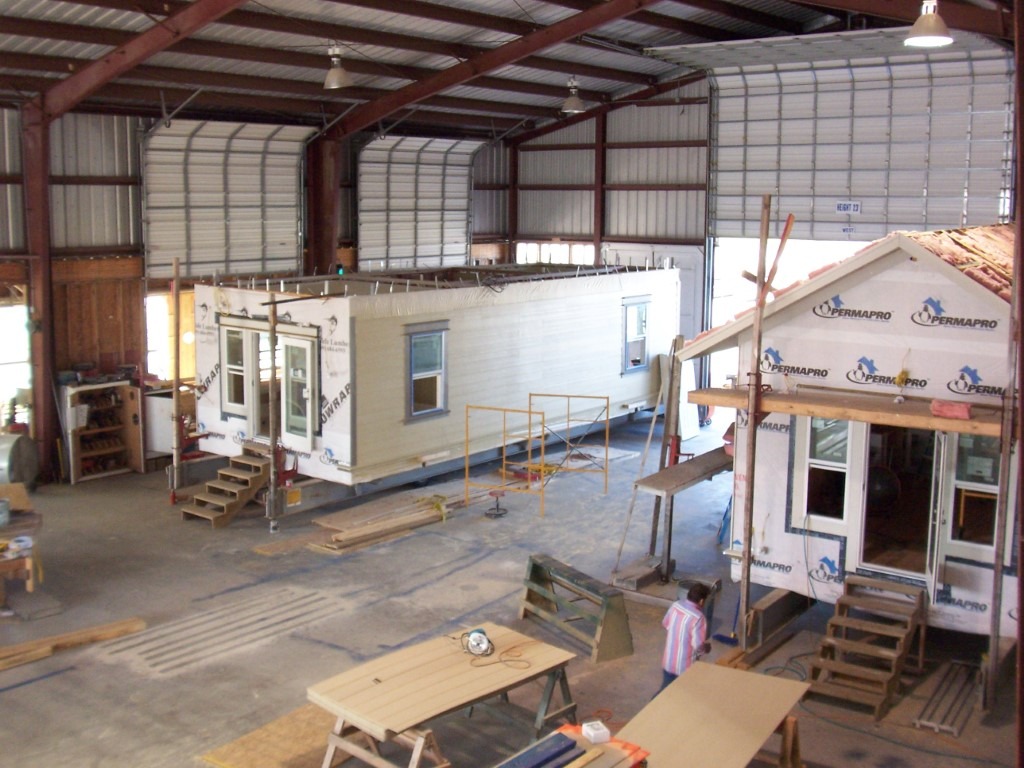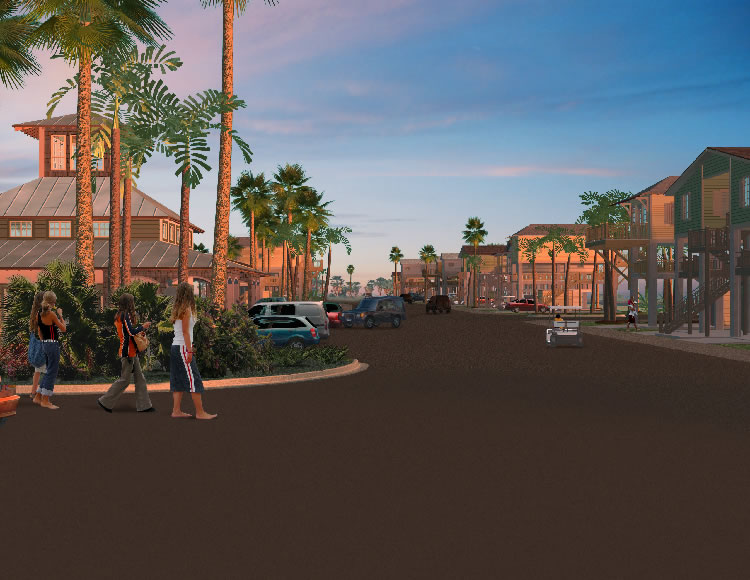Alternative Home Ideas on the Texas Coast
Modular Systems Built Homes
The Basics of Systems Built Modular Construction
Modular Home: A modular home is a home constructed in multiple sections in a factory. It is built to the same building code used by conventional site-builders and is transported to the new home site where it is placed on a permanent foundation.
Modular Manufacturer: A company that constructs modular homes in multiple sections inside a controlled factory.
Modular Builder: The company that sells the home to the homebuyer and is responsible for ordering the home from the manufacturer. The modular builder constructs the foundation for the permanent installation of the home and is responsible for some final finish work after the home has been installed.
Modular Installer: A subcontractor who specialized in the installation of the modular home on the foundation.

The Systems Built Modular Process
THE FACTORY/MANUFACTURER
Modular homes are built in a factory setting where raw materials and design and assembly personnel are brought together in a controlled environment to create a finished product. Construction within a factory eliminates the possibility of damage from weather and allows all materials to be assembled in a protected climate-controlled environment. This is important given the recent problems with mold as it eliminates the possibility of any water infiltrating the house during construction.
THE BUILDER/SELLER
The modular manufacturer does not sell directly to the homebuyer. Instead, homebuyers purchase a modular home from a modular builder, who is responsible for working with the buyer to determine the type and design of home they want. The modular builder then orders the home from the manufacturer. The modular builder is not an agent of the manufacturer, but an independent business owner.
CUSTOMIZATION
The builder and manufacturer will work with the homeowner to determine the type and design of modular home that best suits the purchaser’s needs. Home purchasers are unlimited in the style and size of the home they can have built. These homes are customizable and no two are the same.
CONSTRUCTION & PLAN REVIEW
Before a modular manufacturer begins construction, all building plans must be reviewed and approved in each state where the manufacturer intends to sell homes. Homes must be designed and built to the code for the state where the home will be shipped for final location. The manufacturers contract with state approved third party plan review agencies which conduct plan review on behalf of the state. The modular manufacturer also contracts with a third-party inspection agency that is licensed by the states to perform the in-plant inspection while the home is in production. When the housing sections or modules are complete, the third-party places a label on the home certifying that the home has been manufactured in conformance with the approved plans and complies with all provisions of the building code.
SHIPPING & STABILITY
After construction in the factory the separate modules are loaded for transport. To deal with the rigors of shipping, each modular home has been constructed with twenty to thirty percent more materials than a traditional stick-built home. (For example, drywall is typically glued with a special adhesive and then screwed to the framing). These additional materials increase the structural strength of the home as noted in a recent FEMA study on 1992’s Hurricane Andrew. The study concluded that “the module-to-module combination of units appears to have provided an inherently more rigid system that performed much better than conventional residential framing.”
FINAL ASSEMBLY
After the builder orders the home from the manufacturer, the manufacturer will give the builder specifications for the foundation. The builder is then responsible for preparing the foundation for the modular home. When the home is constructed, it is shipped to the job site. The next day, a crane is used to place the housing modules on the foundation and set the roof in place. By the end of the day, the home has been completely installed and is closed and secured. In the subsequent weeks, the builder will finish the home. This finished work includes securing any remaining roofing shingles, attaching siding and finishing some interior drywall work. Generally, the home is ready for occupancy within several weeks. Prior to moving in, a local building code inspector will make a final inspection and issue an occupancy permit.
The Benefits of Modular Homes
Limited Number of Subcontractors
The modular builder contracts with a limited number of subcontractors. Since most of the construction is performed in the factory, the modular builder has limited responsibilities. Most modular builders will subcontract out the foundation construction. In addition, the crane company and the installation crew are usually subcontractors. This eliminates the possibility that your builder will have delays from a “no-show” subcontractor.
Manufacturer Responsibility
Since most of the work is performed in the factory, the manufacturer is responsible for all of the construction of the home. When a problem results from work done in the factory (which is rare), the manufacturer corrects it. Consequently, ongoing problems with modular homes are unheard of.
Regulation & Inspection
As a result of the intense regulation and inspection of the home during construction, it is extremely rare that a home leaves the factory with a defect in design or manufacturing. The third-party inspection services see to this and assume liability for their plan review and inspection responsibility. Additionally, since modular construction is regulated by the state, the state is typically involved in correcting the problem.
Superior Construction
The larger quantity of construction material used in the modular home results in enhanced structural stability. The material that is used is also often of higher quality than what a stick builder uses, and the material is stored indoors until needed. Additionally, better construction techniques and higher quality control techniques reduce the chances for unforeseen defects. This includes problems such as mold that could arise from moist lumber.
Reduced Construction & Assembly Time
The modular home is completed in the factory in approximately one-third of the time it takes a stick built home to be completed. This eliminates the possibility of an on-site construction-related fire or other problems. The factory-controlled conditions also eliminate the possibility of severe weather delaying the completion of your home. Furthermore, a modular home is not subject to delays from back-ordered materials or unreliable subcontractors. Once the home is delivered it is closed and sealed within days and the remaining onsite work is completed very quickly. Within weeks, the home is available for the buyer to move in. Consequently, the neighborhood children won’t have a chance to play in your uncompleted house and there is no chance for vandals to damage the interior of your home.
Skills and Specialized Training of Modular Builders and Installers
Modular Manufacturers do not choose to deal with builders that are under-skilled and poorly capitalized. Manufacturers have a set list of builders they deal with and are in constant communication with these builders to update them on new techniques and changes in the industry.
Financing
Modular homes are financed in the same manner as conventional homes.
Why Build a Modular Home?
Modular houses are built out of boxes, called modules, which are constructed off site, transported to a building lot, and assembled into a finished home. All the materials – from framing, roofing, and plumbing to cabinetry, interior finish, and electrical – are identical to what you would find in a conventional “stick-built” home. The most striking thing about a modular home is not anything you can see, nor how it is made, but where it is made: in a modern factory designed to build good-quality modular homes.
The modular factory system combines engineering knowledge and factory-production methods to design and build more efficiently and with greater quality control. When done well, efficiency results in lower costs and quality control results in a better product.
Many consumers assume that the primary advantage of modular technology is lower modular home prices. That is only the third most important reason for building a modular home. Faster construction time is the second, and superior quality is the first.
Modular construction has become the construction method of choice for the quality- and cost-conscious house buyer. The best-built modular homes are better built than many stick-built homes. Modular homes offer better materials, state-of-the-art construction technology, superior finished quality, and time and money savings. And you gain all these benefits without sacrificing design or amenities.


